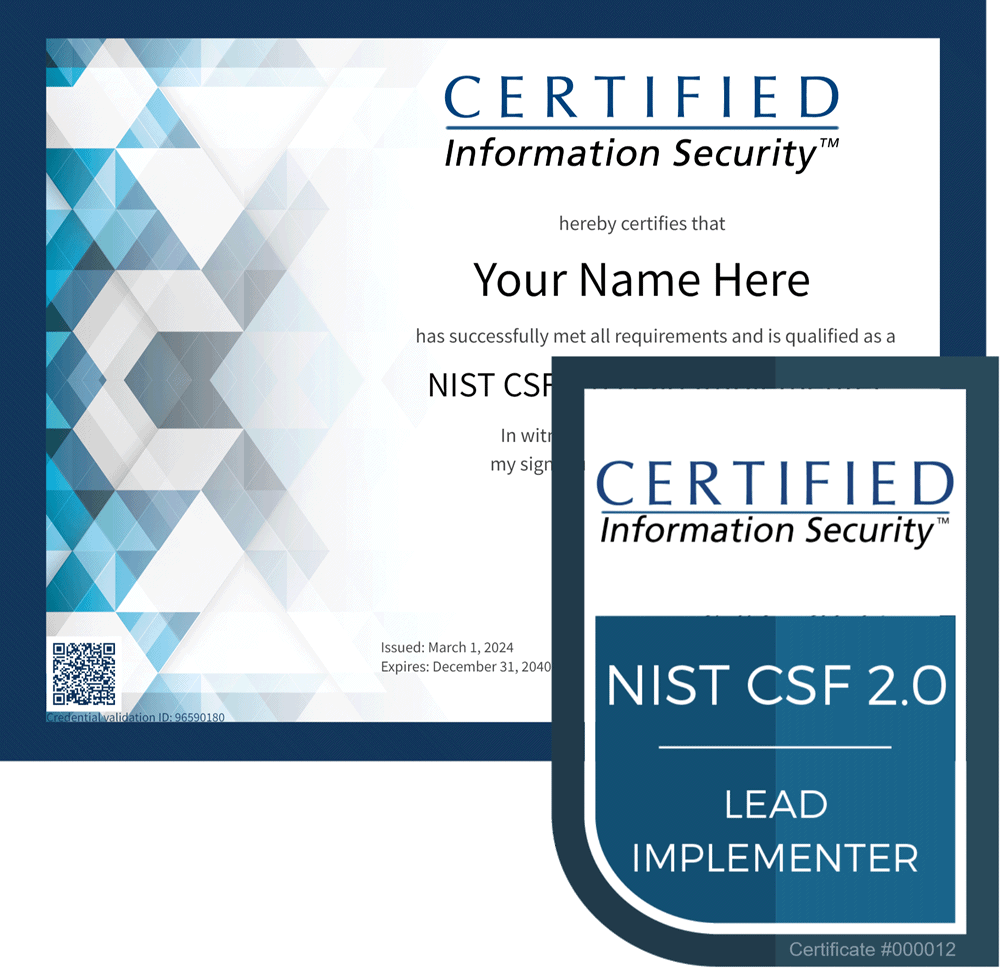NIST cybersecurity framework nist csf 2.0
|
cybersecurity training |
online nist cybersecurity framework nist csf 2.0 program |
online cybersecurity exam course |
|
NIST training online course |
NIST certification online course |
online information security training course |
online NIST Framework training course |
online cisa certification course |
online certification course |
national institute of standards and technology critical infrastructure news events risk framework federal government
NIST Cybersecurity Framework 2.0
Lead Implementer Certification
Lead Implementer Certification
Advance your career! Get trained and certified as an expert
in developing, implementing, and managing cybersecurity
according to the NIST Cybersecurity Framework 2.0 (CSF).
Certified NIST CSF 2.0
Lead Implementer
Lead Implementer
Advance your career.
Get trained and certified
as an expert in developing, implementing,
and managing cybersecurity
according to the
NIST Cybersecurity Framework 2.0 (CSF).
Become a Certified NIST CSF 2.0 Lead Implementer
 The Certified CSF 2.0 LI certification certifies your ability to implement the formal structure, governance, and policy of a robust cybersecurity framework following internationally recognized and respected NIST best practices and standards. Get trained and certified as an expert in developing, implementing, and managing a robust cybersecurity program according to internationally adopted NIST CSF governance and management best practices.
The Certified CSF 2.0 LI certification certifies your ability to implement the formal structure, governance, and policy of a robust cybersecurity framework following internationally recognized and respected NIST best practices and standards. Get trained and certified as an expert in developing, implementing, and managing a robust cybersecurity program according to internationally adopted NIST CSF governance and management best practices.
 Register for a class (in-person or virtual) and get started today!
Register for a class (in-person or virtual) and get started today!
The Cybersecurity Framework 2.0 provides a policy framework of computer security guidance for how public and private sector organizations in the United States and around the world can assess and improve their ability to prevent, detect, and respond to cyber attacks. The framework has been translated to many languages, and is used by the governments of Japan and Israel, among others. It is now the go-to playbook for countless organizations for building a robust data protection strategy. It’s structured along six core functions — Govern, Identify, Protect, Detect, Respond and Recover — each of which captures and curates the essential goals and actions that should be prioritized across the cybersecurity lifecycle.

What does NIST CSF 2.0 deliver for an organization?
The CSF helps make sense of what to do before, during, and after an incident: from shedding light on your data ecosystem and where the vulnerabilities lie; to locking down sensitive data and remediating known risks; to detecting malicious activity and meeting the threat with consistent and repeatable processes; to finally recovering through the quarantine of corrupted data, monitoring of ongoing threat activity, protocol adjustment and related steps.
The beauty is that all this guidance and wisdom comes in the form of a few strategic guidelines that are intuitive and accessible to a wide range of practitioners. Of course, not everything about NIST is voluntary for all organizations (U.S. government contractors, for example, must demonstrate security compliance under NIST 800-171 or risk losing their contracts), and regulations are always changing. That’s why the CSF is still the roadmap — not the engine — to drive your organization toward the most secure data and architectures possible.
A short list of benefits and deliverables includes:
- Superior and unbiased cyber security
- Enables long-term cybersecurity and risk management
- Ripple effects across supply chains and vendor lists
- Bridges the gap between technical and business side stakeholders
- Flexibility and adaptability of the Framework
- Built for future regulation and compliance requirements




















